
image by Eugene Ipavec, 14 September 2006

Last modified: 2014-05-16 by zoltán horváth
Keywords: colombia | invias | ecopetrol |
Links: FOTW homepage |
search |
disclaimer and copyright |
write us |
mirrors
Ministries:
Administrative Departments:
National Institutions:
Superintendencies:
Autonomous Regional Corporations:
The Judicial System:
See also:
During the first term of President Álvaro Uribe, beginning in
2002, ministries were restructured. The President closed and
merged ministries to reduce bureaucracy while assigning duties of
suppressed ministries to Administrative Departments (i.e. the DAS, which is a form of an Administrative
Department).
Here's a list of the current 13 Ministries of the Executive
Branch of Colomba's government (in the correct Order of
Precedence):
- Ministerio de Interior y de Justicia
(Ministry of the Interior and Justice, official website at <www.mij.gov.co>)
- Merging of Ministerio del Interior (Ministry of Interior) and
Ministerio de Justicia (Ministry of Justice) to create a unified
Ministry. (Separated into two ministries in 2011. See below for details. Ed.)
- Ministerio de Relaciones Exteriores (Ministry of Foreign
Affairs, official website at <www.minrelext.gov.co>).
- Ministerio de Hacienda y Crédito Público (Ministry of Finance
and Public Credit, official website at <www.minhacienda.gov.co>)
- Ministerio de Defensa Nacional (Ministry
of National Defense, official website at <www.mindefensa.gov.co>)
- Ministerio de Agricultura y Desarrollo Rural (Ministry of
Agriculture and Rural Development, official website at <www.minagricultura.gov.co>)
- Ministerio de Protección Social (Ministry of Social
Protection, official website at <www.minproteccionsocial.gov.co>)
- Merging of Ministerio de Salud (Ministry of Health) and
Ministerio del Trabajo (Ministry of Labor) to create a unified
ministry
- Ministerio de Minas y Energía (Ministry of Mines and Energy,
official website at <www.minminas.gov.co>)
- Ministerio de Comercio, Industria y Turismo (Ministry of
Commerce, Industry and Tourism, official website at <www.mincomercio.gov.co>)
- Renamed after absorbing several Departamentos Administrativos
(Administrative Departments)
- Ministerio de Educación Nacional (Ministry of National
Eduction, official website at <www.mineducacion.gov.co>)
- Ministerio de Ambiente, Vivienda y Desarrollo Territorial
(Ministry of the Environment, Housing and Regional Development,
official website at <www.minambiente.gov.co>)
- Absorbed the Ministerio de Desarrollo (Ministry of Development)
- Ministerio de Comunicaciones (Ministry of Communications,
official website at <www.mincomunicaciones.gov.co>)
- Ministerio de Transporte (Minisitry of
Transport, official website at <www.mintransporte.gov.co>)
- Ministerio de Cultura (Ministry of Culture, official website at
<www.mincultura.gov.co>).
For further and historic reference of the evolution of Ministries
in the Colombian government see wikipedia.
Source: Colombian
Presidency official website.
E. R., 3 August 2008
List of entities in the Executive Branch of Colombia can be
seen at wikipedia.
Please notice that this is list is based on the areas they cover
according to the Ministries that actually exist in Colombia. Also
this list includes many publicly owned companies, that may be in
the process of being offered by the government to private
investors.
E. R., 4 August 2008
The Colombian Ministerio del Interior y de Justicia (Ministry of Interior and
Justice) has again been separated into two Ministries:
- Ministerio del Interior (Ministry of Interior) (official
website)
- Ministerio de Justicia y del Derecho (Ministry of Justice and Law) (official
website)
They were both established by Decree No. 2897 of August 11, 2011 (they were
split by Law 1444 of 2011).
Source:
http://www.minjusticia.gov.co/NewsDetail/403/1/MinisteriodeJusticiaydelDerecho
Esteban Rivera, 08 December 2011

image by Eugene Ipavec, 14 September 2006
The flag of the Ministerio de Defensa Nacional (Ministry of
National Defense). Its official website located at <www.mindefensa.gov.co>.
E. R., 14 September 2006
Variant
I saw a picture showing a variant of the already existing flag
of the Ministry of National Defense. The flag includes the words
Ministerio de Defensa Nacional.
Source: <www.esinf.mil.co>.
E. R., 5 July 2007
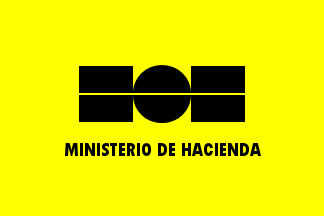
image by Eugene Ipavec, 22 March 2009
The flag of the Ministerio de Hacienda y Crédito Público
(Ministry of Finance and Public Credit) is yellow with the
Logotype of the letters M, H and C for "Ministerio",
"Hacienda", "Crédito".
The Ministry is in charge of designing, coordinating, regulating
and executing the economic, monetary and fiscal policies for
Colombia in order to improve economic and social development.
website at <www.minhacienda.gov.co>.
Source: Photo at
CM&
TV news.
E. R., 22 March 2009
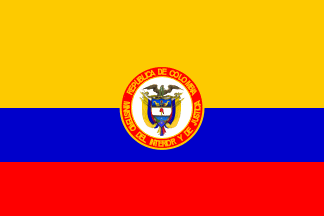
image by Eugene Ipavec, 1 June 2006
Yesterday I saw a broadcast on TV of Minister Sabas Pretelt de
La Vega, the current Minister of Interior and Justice. On the
background there was the flag of this Ministry. The flag is the
Colombian tricolor, with the Coat of Arms on the middle, bordered
by a red fringe, with the words REPUBLICA DE COLOMBIA, in yellow,
capitals, inside the fringe, and on the bottom it reads
MINISTERIO DEL INTERIOR Y DE JUSTICIA, also in yellow.
The official websites of this Ministry are: <www.mininteriorjusticia.gov.co>,
<www.mij.gov.co>.
E. R., 1 June 2006
The Colombian Ministerio del Interior y de Justicia (Ministry of Interior and
Justice) has again been separated into two Ministries:
- Ministerio del Interior (Ministry of Interior) (official
website)
- Ministerio de Justicia y del Derecho (Ministry of Justice and Law) (official
website)
They were both established by Decree No. 2897 of August 11, 2011 (they were
split by Law 1444 of 2011).
Source:
http://www.minjusticia.gov.co/NewsDetail/403/1/MinisteriodeJusticiaydelDerecho
Esteban Rivera, 08 December 2011
The flag of the Ministerio de Justicia y del Derecho.
Image is a TV screenshot taken from CM& tv
news, on 7 December, 2011)
Esteban Rivera, 08 December 2011
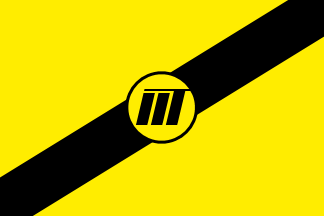
image by Eugene Ipavec, 8 July 2006
I recently saw on the entrance of the Airport Jose Maria
Cordova in the Municipality of RIonegro (Department of
Antioquia), the flag of the Ministerio de Transporte (Ministry of
Transportation). The flag is a horizontal shape flag, all yellow
(the same shade as the Colombian national flag) and it has a
black diagonal line going from the bottom hoist to the top fly.
The width of this stripe is the same as the small circular logo.
Official website:<www.mintrasnporte.gov.co>.
E. R., 19 June 2006
Ministerio de Comercio, Industria y Turismo (Ministry of
Commerce, Industry and Tourism) was established in 2002, and its
functions were outlined by decree No. 210, of February 3, 2003.
It was emerged from the merger of the Ministerio de Comercio
Exterior (Ministry of External Trade) and the Ministerio de
Desarrollo Económico (Ministry of Economic Development).
The emblem of the Ministry of Economic Development, was designed
by Designer Dicken Castro, in 1968. The emblem can be found at
<www.proyectod.com>.
E. R., 23 August 2008

image by Zoltan Horvath, 26 March 2011
The flag of the Ministerio de Protección Social is a horizontal white
flag, with the Coat of Arms of Colombia in the middle with the motto
"Libertad y Orden" in black letters, and below the inscription
"Ministerio de Protección Social" and below, "República de Colombia"
also in black.
Image is a screenshot of
Caracol TV news taken on January 25, 2010)
For further information please see:
Ministerio de
Protección Social (official website)
Esteban Rivera, 7 March 2011
The full list of the current six Departamentos Administrativos
(Administrative Departments) is as follows:
- Agencia Presidencial para la Acción Social y la Cooperación International
(Presidential Agency for Social Action and International Cooperation)
- DAPR - Departamento Administrativo de la Presidencia de la
República (Administrative Department of the Presidency of the
Republic, offiical website at <www.presidencia.gov.co>)
- DAFP - Departamento Administrativo de la Función Pública
(Public Service Administrative Department, official website at
<www.dafp.gov.co>)
- DANE - Departamento Administrativo Nacional de Estadística
(National Statistics Administrative Department, official website
at <www.dane.gov.co>)
- DANSOCIAL - Departamento Administrativo de Economía Solidaria
(Solidarian Economy Administrative Department, official website
at <www.dansocial.gov.co>)
- DAS - Departamento Administrativo de Seguridad
(Security Administrative Department)
- DNP - Departamento Nacional de Planeación, official
abbreviation (National Planning Department, official website <www.dnp.gov.co>).
Sources: Colombian
Presidency official web site, Ministry
of Interior and Justice official web site.
E. R., 3 August 2008
There's a new Bill recently approved by Congress that creates another
Administrative Department. The Agencia Presidencial para la Acción
Social y la Cooperación International (commonly known as "Acción
Social") (Presidential Agency for Social Action and International
Cooperation) will be established as an Administrative Department and will be in charge
of taking care of the victims of the Colombian Armed conflict from
1985 onwards. Victims from previous years (1984 and backwards will
only be compensated simbolically). Source:
http://www.cmi.com.co/?nt=61683
Acción Social was established through Decree No. 2467 of July 2005.
Source:
http://www.accionsocial.gov.co/contenido/contenido.aspx?catID=3&conID=544&pagID=821
In this new reorganization, Acción Social will be merged with the CNRR
(Comisión Nacional de Reparación y Reconciliación) (National
Reparation and Reconciliation Commission), in order to provide victims
of the armed conflict with integral social and economic support. The
CNRR emerged from Law Ley 975 of 2005 dubbed "Justicia y Paz" (Justice
and Peace). The CNRR was established through Decree No. 4760 of 2005.
Source: http://www.cnrr.org.co/contenido/09e/spip.php?article2629
Esteban Rivera, 13 April 2011

image by Eugene Ipavec, 9 November 2005

image by Eugene Ipavec, 9 November 2005

reverse
image by Eugene Ipavec, 2 March 2006
.jpg)
Coat of Arms
image contributed by E. R., 12 June 2005
Translated from <www.das.gov.co>
(located by Dov Gutterman): "On rectangular shape,
is formed by sky blue and white colors in two equal horizontal
bands, with sky blue on top and white on bottom, the national
tricolor will appear in circular 'cucarda' shape in the center of
the flag."
Departamento Administrativo de Seguridad (Administrative Security
Department), is Colombia's secret police, in charge of home land
security, immigration, emigration, bodyguards for public
servants, criminal investigations, etc.
Carlos Thompson, 5 November 2004
Coat of Arms of DAS (Security, Intelligence and Secret
Service) is taken from the book "Himnos y Símbolos de
Nuestra Colombia" , page 278. Written in 2000 by Julio Cesar
García, edited by Camer Editores. ISBN 958-33-1489-7.
E. R., 12 June 2005
There is an additional flag which has the same color pattern,
only with the DAS Coat of Arms in the middle.
E. R., 9 November 2005

image by Eugene Ipavec, 6 October 2010
INRAVISION stands for Instituto Colombiano de Radio y Televisión (National
Institute of Radio and Television). It was created by Decre No. 3267 of December
20, 1963. It made public radio and television broadcasts thorughout its
existence, and it depended on the Ministry of Communications.
Source:
http://es.wikipedia.org/wiki/Inravisi%C3%B3n
It was however shut down in 2004 because of financial difficulties, and a new
organization was created, the RTVC (Radio Televisión Nacional de Colombia),
created by Decree No. 3525 del 28 de octubre de 2004.
Source:
http://es.wikipedia.org/wiki/Radio_Televisi%C3%B3n_Nacional_de_Colombia
The RTVC currently operates four public broadcast channels, including the Congres Channel and also six radio stations. However I have not seen a flag of the RTVC,
Source:
http://es.wikipedia.org/wiki/Radio_Televisi%C3%B3n_Nacional_de_Colombia
The RTVC has its own official website: http://www.rtvc.gov.co/
The flag of INRAVISION was yellow background, plus the
logo on the middle, very much like some other government flags ( i.e.
Ministry of Finance and Public Credit and Ministry of Transportation.
The logo was designed by David Consuegra in 1964.
Source:
http://www.proyectod.com/finalizacion/historia/3hisgra60s.html
Esteban Rivera, 31 August 2009

image by Eugene Ipavec, 8 July 2010
There is a news report which appeared on August 30, 2009 mentioning the Colombian President was affected by the swine flu (or AH1N1 flu). In the
link on the
fifth video link the current Ministro de Protección Social (Social Protection Minister) Diego Palacio is reporting the medical treatment to be followed, to a reporter from RCN channel. On the back, to the right, one can see the flag of the INS (Instituto Nacional de Salud, in English National Health Institute). It is a white background plus the
symbol in the middle.
The symbol's explanation is here and its designer is Dicken Castro, a very renowned Designer, who also designed the
logo for the Ministerio de Desarrollo Económico (Ministry of Economic Development) in 1968, now a defunct Ministry which was absorbed by the Ministry of the Environment and Housing to form the Ministry of the Environment, Housing and Regional Development in the 2000's.
The INS has traces back its roots to 1917 with the establishment of the Laboratorio Samper Martínez (Samper Martínez Lab). Then it merged with other labs to become the INS in 1975.
Source: http://www.ins.gov.co/?idcategoria=1196
For more information on the INS please refer to: INS (official website)
http://www.ins.gov.co/
Esteban Rivera, 31 August 2009
List of Superintendencies (total of 10) in no particular
order:
- Superintendencia de Subsidio Familiar (Family Subsidy
Superintendency, official website at <www.ssf.gov.co>)
- Superintendencia de Economía Solidaria (Solidarian Economy
Superintendency, official website at <www.supersolidaria.gov.co>)
- Superintendencia Nacional de Salud (National Health
Superintendency, official website at <www.supersalud.gov.co>)
- Superintendencia de Industria y Comercio (Industry and Commerce
Superintendency, official website at <www.sic.gov.co>)
- Superintendencia Financiera de Colombia (Fnancial
Superintendency of Colombia, official website at <www.superfinanciera.gov.co>).
Merger of Superintendencia Bancaria de Colombia (Colombian
Banking Superintendency) and Superintendencia de Valores
(Securities Superintendency)
- Superintendencia de Sociedades (Societies
Sperintendency)
- Superintendencia de Vigilancia y Seguridad Privada (Vigilance
and Private Security Superintendency, official website at <www.supervigilancia.gov.co>)
- Superintendencia de Notariado y Registro
(Notary and Registry Sperintendency)
- Superintendencia de Servicios Públicos Domiciliarios (Public
Domiciliary Services Superintendency, official website at <www.superservicios.gov.co>)
- Superintendencia de Puertos y Transporte (Ports and
Transportation Superintendency, official website at <www.supertransporte.gov.co>).
E. R., 4 August 2008
The Superintendencia de Economía Solidaria (Solidarian Economy
Superintendency) was established by Law 454 of 1998. It is in charge of the
inspection, control and surveillance of the Solidarian Economic organizations
and its activities)
Source:
http://www.supersolidaria.gov.co/nuestra_entidad/resena.php?m=1
Its flag is seen
here. The flag is a white horizontal flag with the
logo in the middle.
The flag can also be seen in this video (0:42):
http://www.noticiasuno.com/noticias/todas-las-entidades-que-vigila-la-supersolidaria-reportan-a-confecoop-.html
For additional information please see:
Superintendencia de
Economía Solidaria (official website)
Esteban Rivera, 06 June 2011
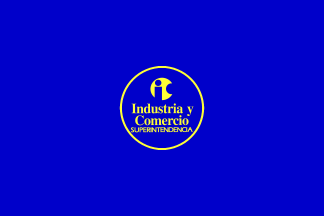
image by Eugene Ipavec, 19 July 2011
Today on RCN news channel (
http://www.canalrcnmsn.com/ ) they showed the flag of the SIC (Superintendencia
de Industria y Comercio) (Industry and Commerce Superintendency).
Image of flag. (screenshot from RCN news channel TV broadcast) (blue flag on the
right). The flag is a horizontal blue background, with the emblem in a thin
yellow outline with the emblem of the SIC in the middle, having the logo (a
stylized "I" and "C", standing for "Industria" and "Comercio", the areas which
it oversees) and the name below, reading "Industria y Comercio" in yellow as
well.
Esteban Rivera, 18 July 2011
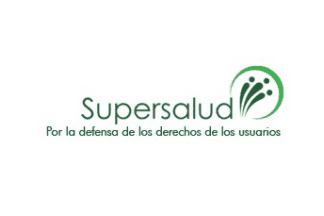
image by Zoltan Horvath, 20 August 2013
The Superintendencia de Salud was established by Law 1650 of 1977 as
Superintendencia de Seguros de Salud (Health Insurance Superintendency,
overseeing mainly the ISS
Source:
http://www.supersalud.gov.co/supersalud/Default.aspx?tabid=73
The flag is a white horizontal flag with the
logo and
the motto in the middle. The motto is "Por la defensa de los derechos de los
usuarios" (For the defense of users' rights).
Screenshot taken from
CM& news on May 2, 2013).
This flag should be placed In the Government organizations section, under the
Superintendencies overview.
For additional information go to:
Superintendencia Nacional de Salud (National Health Superintendency)
official website.
Esteban Rivera, 03 May 2013
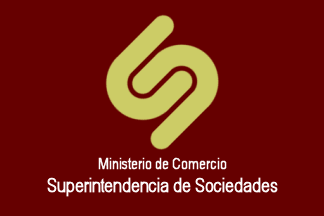
image by Eugene Ipavec, 24 January 2008
The flag of the Superintendencia de Sociedades (Societies
Superintendency), official website at <www.supersociedades.gov.co>.
It is a technical organization of the Colombian government. It is
one of ten such organizations in charge of the inspection,
control and surveillance of its own aspect.
Source: Caracol news channel (<www.caracolnoticas.com>),
TV caps taken on July 25, 2006.
E.R., 24 January 2008

Variant of flag
image by Zoltan Horvath, 24 March 2011
On March 16, in a news broadcast by local channel
Caracol TV an
alternate version of the flag of the Superintendencia de Sociedades was shown.
It is a white horizontal background flag, with the logo (http://www.leasingbancoldex.com/images/super_sociedades.png
) in the middle.
The cropped image taken from:
http://1.bp.blogspot.com/_dSnkryKhNww/SxPiIrmlaeI/AAAAAAAAAJk/BLJ6Go4OMbc/s1600/SS1.JPG
Source:
http://noticiascomercioindustriaturismonov.blogspot.com/
The Supersociedades was created by Law 58, 1931 under the name "Superintendencia
de Sociedades Anónimas" (Superintendency of Incorporated (or Limited) Societies),
later reformed by Law 44, 1981
and also Decree No. 2059 of 1981.
Source:
http://www.supersociedades.gov.co/ss/drvisapi.dll?MIval=sec&dir=280
Esteban Rivera, 23 March 2011
I saw on the news on August 27, 2008 and during the news
edition, I saw the flag of the Superintendencia de Notariado y
Registro (Superintendency of Notary and Registry, official web
site at <www.supernotariado.gov.co>).
It is a technical organization part of the Ministry of
Interior and Justice and is in charge of the inspection,
control and surveillance of Notary's documentation and public
documents regulation.
The flag is the logo on a white backrgound. The Logo can be seen
at <www.mastersoftcolombia.com>.
Its motto is LA GUARDIA DE LA FE PUBLICA (The Guardian of Public
Faith) and on the logo it reads LA FE PUBLICA.
E.R., 30 August 2008
Any CAR (Corporación Autónoma Regional) (Regional Autonomous Corporation) is
a public corporate entity integrated with all other relevant territorial
authorities that together belong to a geographical basin or ecosystem and they
are in charge of enforcing the environmental policies of the Ministerio del
Medio Ambiente (Ministry of Environment) in that specific region.
They were first mentioned in Article 23, Law 99 of December 22, 1993, and then
each CAR was established by a particular Decree later.
Sources:
http://www.minambiente.gov.co//contenido/contenido.aspx?catID=554&conID=4040
http://www.corpoguavio.gov.co/espanol/index.php?option=com_content&task=view&id=\14&Itemid=27
The full list of CAR's is seen here (total of 33):
http://es.wikipedia.org/wiki/Corporaciones_Aut%C3%B3nomas_Regionales
http://www.humboldt.org.co/sina/corporaciones.htm
All the CAR's are represented in ASOCARS, the Association of all the CAR's. Each
CAR has its own logo and flag.
For the logos of all 33 CAR's please see the following:
http://www.asocars.org.co/Cartilla/Cartillaconmusica.html
Another CAR flag is seen here:
http://www.car.gov.co/tools/microsThumb.php?src=recursos_user/imagenes//Noticias\/Marzo_2011/MARC_GIRARDOT.jpg&w=250
(Flag of the CAR of Cundinamarca).
Source:
http://www.car.gov.co/?idcategoria=16040
However there's currently a Bill in Congress that estipulates the closure of 32
of these CAR's given the poor response and bad management that they faced during
the 2010 local flood crisis.
Source:
http://www.eltiempo.com/archivo/documento/CMS-8791343 (January 20,
2011)
Esteban Rivera, 30 March 2011
Each CAR (Corporación Autónoma Regional, Autonomous Regional Corporation) is
a government mechanism to watch over the ecosystem in each specifically
jurisdiction where it operates, and it is funded by the central government, and
even though they are semi independent organizations (descentralized institutions),
they are organization-wise dependent to the Ministerio de Ambiente y Desarrollo
Sostenible (Ministry of Environment and Sustainable Development) (which chenged
its name from Ministerio de Ambiente, Vivienda y Desarrollo Territorial (Ministry
of the Environment, Housing and Regional Development).
ALL the CARs (Corporaciones Autónomas Regionales, Autonomous Regional
Corporations) are together in the ASOCARS (Asociación de Corporaciones Autónomas
Regionales y de Desarrollo Sostenible, Association of Autonomous Regional
Corporations and Sustainable Development) (official website:
http://www.asocars.org.co/
). The Statutes of the ASOCARS are established in its Acta 058 del Libro III de
Actas de la Asamblea General (Act 058 of the Third Book of Acts of the General
Assembly):
http://www.asocars.org.co/index.php/images/archivos/ESTATUTOS.pdf
Sources:
http://www.minambiente.gov.co//contenido/contenido.aspx?conID=7706&catID=1252
(Ministry of Environment and Sustainable Development) and
http://www.asocars.org.co/index.php/iquienessomos
Esteban Rivera, 24 March 2012
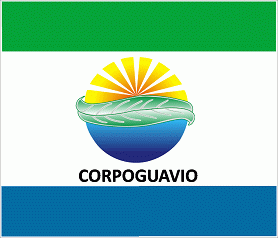
image located by
Esteban Rivera, 30 March 2011
"CORPOGUAVIO is a public corporation created under the law, with
administrative autonomy, legal personality and its own capital, that is part of
the territorial entities that constitute geographically the same ecosystem or
configure a geopolitical, bio-geographic or hydro-geographic unit and legally
charged with administering, within the area under its jurisdiction, the
environment and renewable and non-renewable natural resources, and promoting
sustainable development in compliance with the legal provisions and policies of
the ministry of the environment."
Source :
http://www.bnamericas.com/company-profile/en/Corporacion_Autonoma_Regional_del\_Guavio-CORPOGUAVIO.
The flag of the Corporación Autónoma Regional del Guavio is presented
here.
"La Corporación Autónoma Regional del Guavio - Corpoguavio adoptó un diseño de
bandera que presenta como característica básica el tener una gran fuerza
simbólica, dando importancia al azul y el verde como colores representativos. El
diseño de la bandera muestra tres franjas horizontales, las de los extremos de
igual tamaño, y la central un poco más grande en su orden: azul, blanco y verde
representando las tres actividades básicas de la Corporación: Protección del
recurso agua, Trasparencia y Compromiso con el medio ambiente. En la franja
blanca central se ubica el Logosímbolo en los colores originales.
La bandera debe colocarse en todos los eventos importantes para la Corporación
como uno de sus símbolos representativos.
Diseño: JAIRO NICOLÁS YEPES VASQUEZ"
Translation:
"Regional Autonomous Corporation Guavio - Corpoguavio adopted a flag design that
presents a basic to have great symbolic force, stressing the blue and green as
representative colors.
The design of the flag shows three horizontal bands, the ends of equal size, and
plant a little larger in order: blue, white and green representing the three
basic activities of the Corporation: Protection of water resources, Transparency
and Commitment to the environment. In the central white stripe logo symbol is
located in the original colors.The flag should be placed in all major events for
the Corporation as one of its representative symbols.
Design: JAIRO NICHOLAS YEPES VASQUEZ "
Valentin Poposki, 30 August 2010
The image CORPOGUAVIO can be found here:
http://www.corpoguavio.gov.co/espanol/images/stories/bandera(4).png
Esteban Rivera, 30 March 2011
The Colombian Judicial system has four High Courts, which are:
- Corte Constitucional (Constitutional Court): Established by the
1991 Political Constitution, composed by seven Magistrates and
it's in charge of safekeeping the principles of the Constitution
and the Constitutionality of the administrative actions of the
government. Its official website is <www.constitucional.gov.co>
- Corte Suprema de Justicia (Supreme Court of Justice): Since the
Colombian first declaration of independence (July 20, 1810) and
the establishment of several independent States like Tunja (1811), Antioquia
(1812), Cartagena de Indias (1812) and
Cundinamarca (1812), each State had its
own organ in charge of the administration of justice. Later, when
several States established the Provincias Unidad de la Nueva
Granada (United Provinces on New Granada),
on September 23rd, 1814, the Alto Tribunal de Justicia (High
Tribunal of Justice) was established. Later during the Republic
of Colombia (better known as the Great
Colombia, a Court was created in the Constitution of 1821 of
August 30, named Alta Corte de Justicia (High Court of Justice).
Later, when the Great Colombia dissolved, the Republic of New Granada was formed, and on
its Constitution of 1832 of February 29, the Corte Suprema de
Justicia (Supreme Court) was established. Then on May 20, 1853
during the period of the Republic of New Granada, the Corte
Suprema de la Nación (Nation Supreme Court) is established. Then
during the period of the Grenadine
Confederation on the Constitution of 1858 of May 22, the
Courte Suprema (Supreme Court) was the organ in charge. Then
during the period of the Estados Unidos de Colombia (United States of Colombia) the
Constitution of May 8, 1863 established the Corte Suprema Federal
(Supreme Federal Court). Then on the establishment of the
República de Colombia (Republic of Colombia) on the Constitution
of August 4, 1886, the organ was renamed Corte Suprema de
Justicia (Supreme Court of Justice). This Court was based on the
Spanish Law of its Appeal Court of 1885, which at the same time
was inspired on the French Appeal Court. It currently is made up
of seven Magistrates.
- Consejo de Estado (Council of State): It was first established
by Simón Bolívar by Presidential Decree as President of the
Republic of Venezuela in the city of Angostura (now called Ciudad Bolívar , on the Department of
Bolivar, of the Republic of Venezuela), on October 30,
1817 and it was based on the same institution created by Napoleon
in France back in 1799. It was an organ that replaced the
citizens in the popular election bodies (democratic bodies) and
help to make decisions at a State level. On the 1821 Constitution
it worked as the Consejo de Gobierno (Government Council). On
August 27, 1828, under Decree by Simón Bolívar the rules for
the Consejo de Estado are established, changing only the number
of representatives in the 1830 Constitution . The 1832
Constitution changes the number of Representatives and also
establishes the Consejo de Gobierno. The 1843 Constitution
supresses the Consejo de Estado but allows the Consejo de
Gobierno, which remained during the 1858 Constitution as well.
During the periods of the Confederación Granadina (Grenadine
Confederation, 1856-1861), the Estados Unidos de Nueva Granada
(United States of New Granada, 1861) and the Estados Unidos de
Colombia (United States of Colombia, 1861-1886) there is no
mention of either the Consejo de Estado or Consejo de Gobierno.
In the 1886 Constittuion it reappears as Consejo de Estado
working as a consultant organ and also preparing the Acts to pass
to Congress. Later during the dictatorship of Rafael Reyes, the
Consejo de Estado was abolished by Constitutional Ammendment No.
10, of 1905. Then by Constitutional Ammendment of September 10,
1914 the establishment of the Consejo de Estado is permanent
being the highest consultant government body in terms of
administrative issues.
- Consejo Superior de la Judicatura (Judiciary Superior Council):
It was established in the Constitution of 1991, although several
attempts were made to establish an organ of such carachteristics
back in the 1970's and 1980's. It is in charge of the
administration of justice, that is, the supervision of all judges
around the country.
Source: Rama Judicial (Judiciary Branch) official
website at <www.ramajudicial.gov.co>.
E. R., 10 September 2006
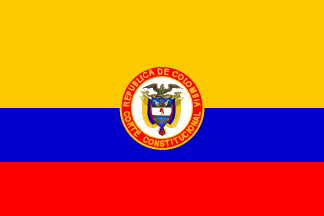
image by Eugene Ipavec, 10 September 2006
I recently saw the flag of the Corte Constitucional
(Constitutional Court) of Colombia on August 15, 2006, on the TV
news channel Caracol
Noticias.
E. R., 10 September 2006
On June 6 I spotted the flag of the Colombian Supreme Court of Justice seen
here.
(Source:
http://protocolocomentarios.blogspot.com/search/label/escudos)
It is the Colombian tricolor with CoA in the middle, with the words on top of
the CoA being REPÚBLICA DE COLOMBIA in bold capital yellow letters, and on the
bottom it reads CORTE SUPREMA in bold capital yellow letters.
Esteban Rivera, 13 June 2011